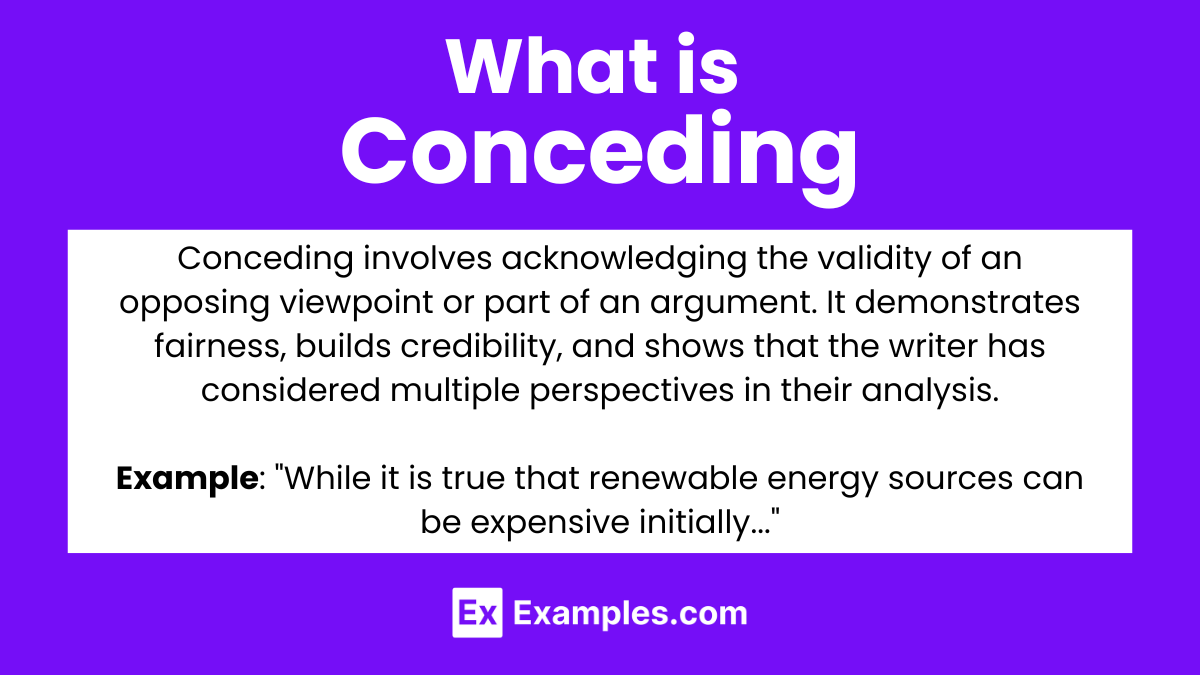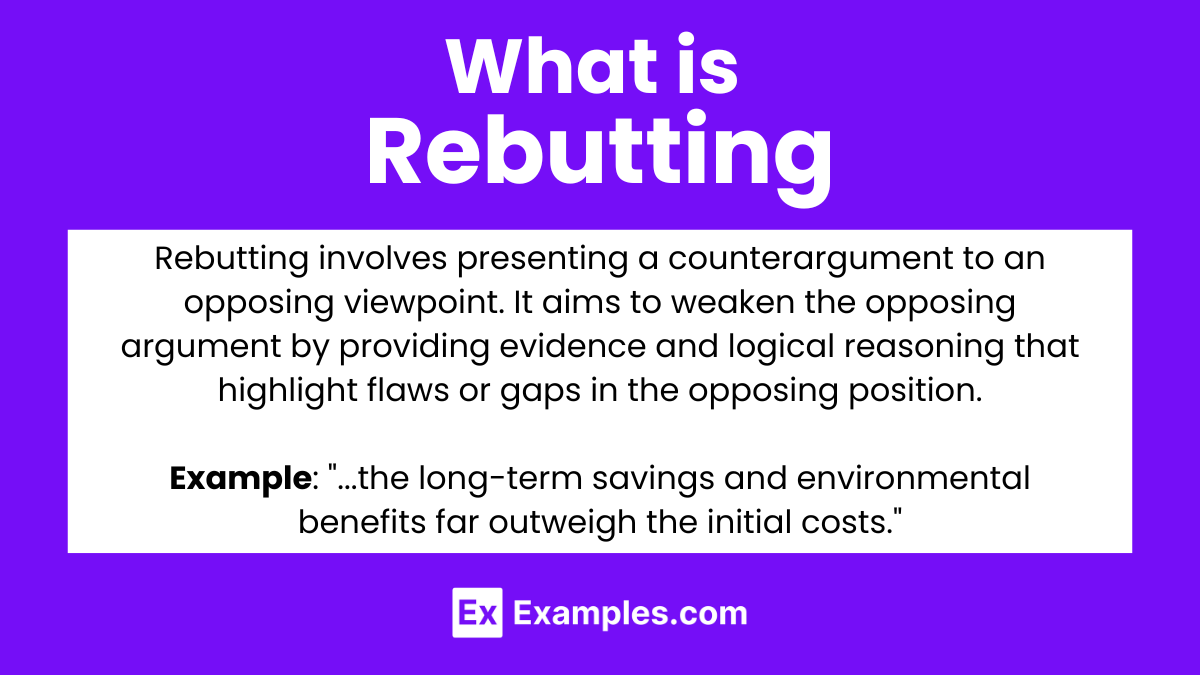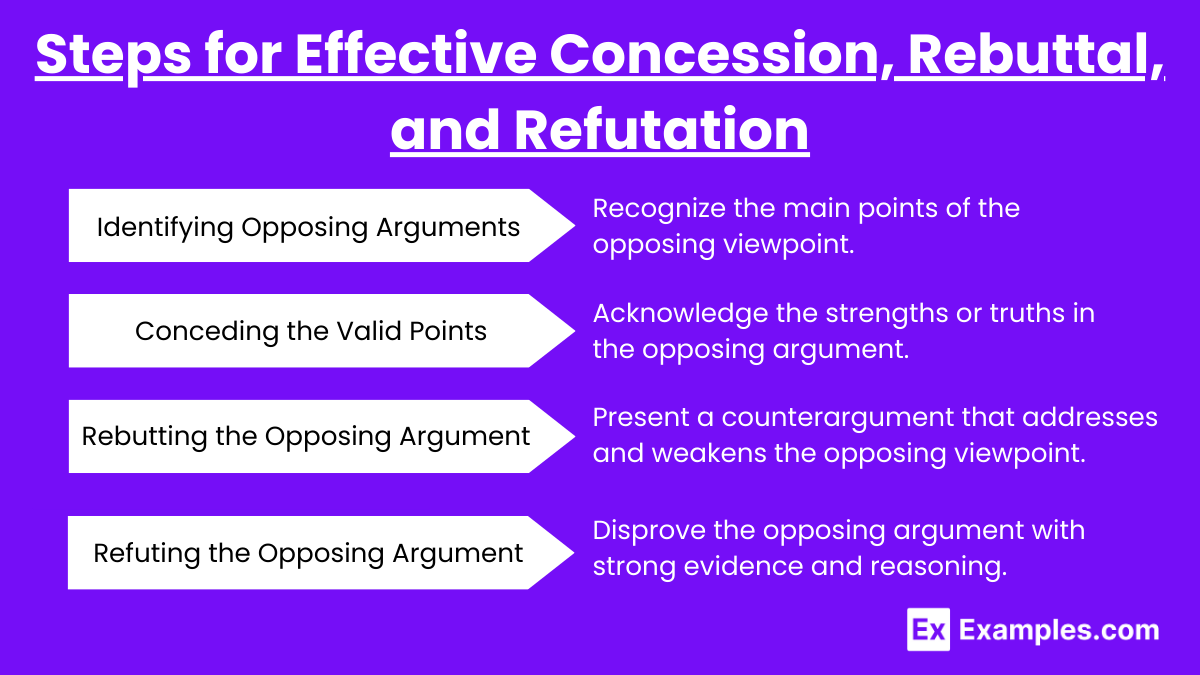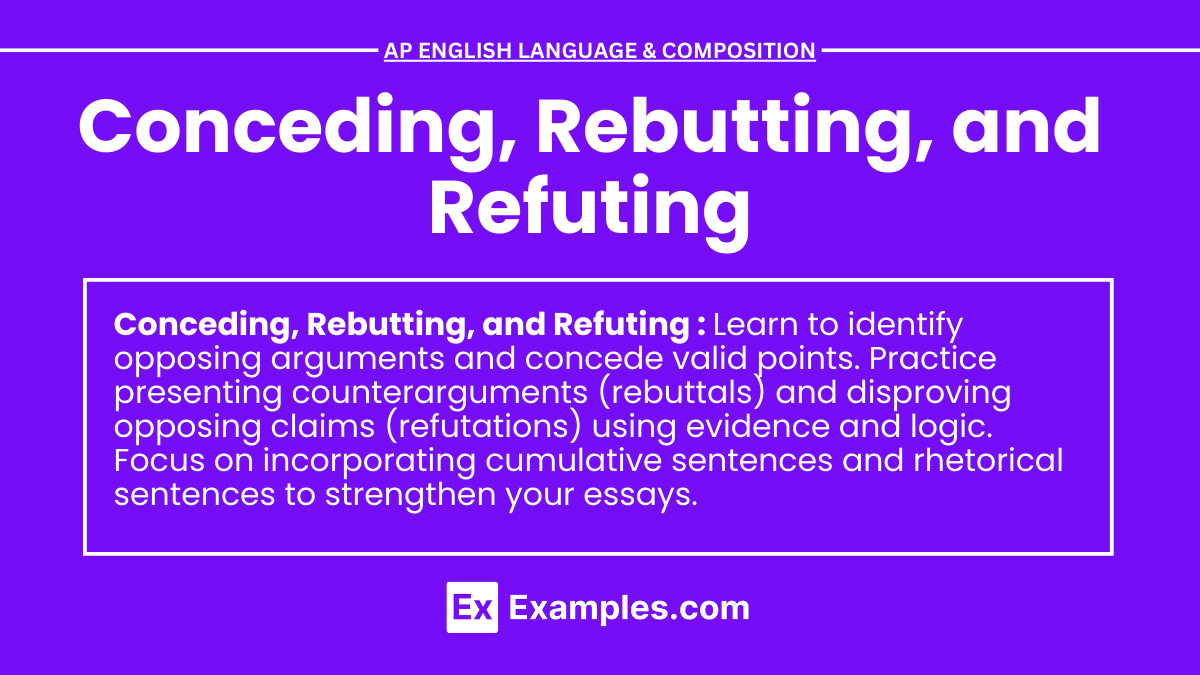In the AP English Language and Composition exam, mastering the techniques of conceding, rebutting, and refuting is essential for developing persuasive and well-rounded essays. Whether engaged in argumentative writing or delivering an argumentative speech, effectively incorporating rhetorical sentences and cumulative sentences enhances the impact of your arguments. These skills involve acknowledging opposing viewpoints, presenting counterarguments, and disproving opposing claims, thereby creating a balanced and compelling argument. By mastering these techniques, you can ensure your writing is clear, persuasive, and resonant with your audience.
Learning Objectives
By studying the topic of conceding, rebutting, and refuting, students will achieve several key learning objectives. They will enhance their critical thinking skills by evaluating and addressing opposing viewpoints. Students will learn to use cumulative sentences and rhetorical sentences to strengthen their explanatory essays and expository essays. They will develop the ability to craft a strong final thesis statement that effectively incorporates concessions, rebuttals, and refutations. Mastery of these techniques will enable students to produce well-structured, balanced, and persuasive arguments in their writing.
Conceding

- Definition: Acknowledging the validity of an opposing viewpoint or part of an argument.
- Purpose: Shows fairness, builds credibility, and demonstrates thorough understanding.
- Techniques:
- Partial Concession: Acknowledge a valid point without conceding the overall argument.
- Full Concession: Agree with the opposing point entirely but follow with a rebuttal.
- Example: “While it is true that renewable energy sources can be expensive initially…”
Rebutting

- Definition: Presenting a counterargument to an opposing viewpoint.
- Purpose: Weakens the opposing argument and strengthens your position.
- Techniques:
- Evidence: Use data, statistics, and expert opinions.
- Logical Reasoning: Highlight flaws or gaps in the opposing argument.
- Example: “…the long-term savings and environmental benefits far outweigh the initial costs.”
Refuting

- Definition: Directly disproving an opposing argument with evidence and logic.
- Purpose: Completely nullifies the opposing viewpoint.
- Techniques:
- Contradictory Evidence: Present evidence that directly contradicts the opposing claim.
- Logical Fallacies: Point out logical fallacies in the opposing argument.
- Example: “Moreover, studies show that renewable energy can become cost-effective within a few years, making the initial expense a worthwhile investment.”
Steps for Effective Concession, Rebuttal, and Refutation

1. Identifying Opposing Arguments
- Definition: Recognize the main points of the opposing viewpoint.
- Techniques:
- Close Reading: Carefully read and understand the opposing argument.
- Contextual Analysis: Consider the context in which the opposing argument is made.
- Example: “Opponents argue that implementing renewable energy is impractical due to high costs.”
2. Conceding the Valid Points
- Definition: Acknowledge the strengths or truths in the opposing argument.
- Techniques:
- Fair Representation: Present the opposing argument accurately and without bias.
- Partial Agreement: Concede to the part of the argument that is valid.
- Example: “It is true that the initial setup cost for renewable energy systems is high.”
3. Rebutting the Opposing Argument
- Definition: Present a counterargument that addresses and weakens the opposing viewpoint.
- Techniques:
- Provide Evidence: Support your counterargument with credible evidence.
- Logical Analysis: Use logical reasoning to highlight the flaws in the opposing argument.
- Example: “However, these costs are offset by the significant savings on energy bills over time.”
4. Refuting the Opposing Argument
- Definition: Disprove the opposing argument with strong evidence and reasoning.
- Techniques:
- Contradictory Data: Present data that directly contradicts the opposing claim.
- Expose Fallacies: Identify and explain logical fallacies in the opposing argument.
- Example: “In fact, a study by the National Renewable Energy Laboratory found that renewable energy systems pay for themselves within 5 to 10 years.”
Techniques for Effective Argumentation
Use of Ethos, Pathos, and Logos
- Ethos: Establish credibility by using reliable sources and demonstrating knowledge.
- Example: Citing expert opinions and studies.
- Pathos: Appeal to the audience’s emotions to strengthen your argument.
- Example: Highlighting the environmental benefits of renewable energy.
- Logos: Use logical reasoning and evidence to support your argument.
- Example: Presenting cost-benefit analyses and long-term financial benefits.
Logical Structure
- Definition: Organize your argument in a logical sequence that is easy to follow.
- Techniques:
- Introduction: Present the main argument and thesis statement.
- Body: Address opposing arguments with concessions, rebuttals, and refutations.
- Conclusion: Summarize the main points and reinforce the thesis.
- Example: “While the initial costs of renewable energy are high (concession), the long-term benefits make it a sustainable choice (rebuttal), and studies confirm its cost-effectiveness over time (refutation).”
Examples
Example 1: Argumentative Essay on Renewable Energy
- Thesis Statement: “Renewable energy is essential for sustainable development.”
- Concession: “Critics argue that renewable energy sources are too costly to implement widely.”
- Rebuttal: “However, these initial costs are mitigated by the long-term savings on energy expenses.”
- Refutation: “Moreover, research shows that renewable energy can become cost-effective within a few years, making it a practical and sustainable choice.”
Example 2: Argumentative Essay on Education Reform
- Thesis Statement: “Education reform is necessary to improve student outcomes.”
- Concession: “Some educators believe that standardized testing is a reliable measure of student performance.”
- Rebuttal: “While standardized tests provide some insights, they do not capture all aspects of student learning.”
- Refutation: “Furthermore, studies indicate that alternative assessment methods can provide a more comprehensive evaluation of student abilities.”


